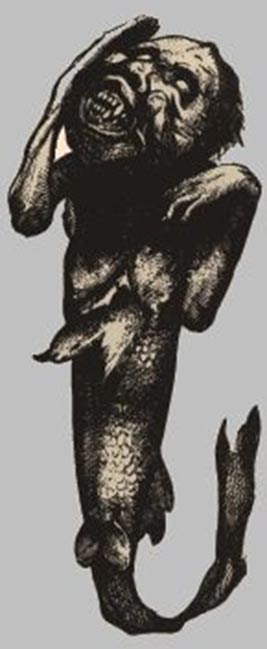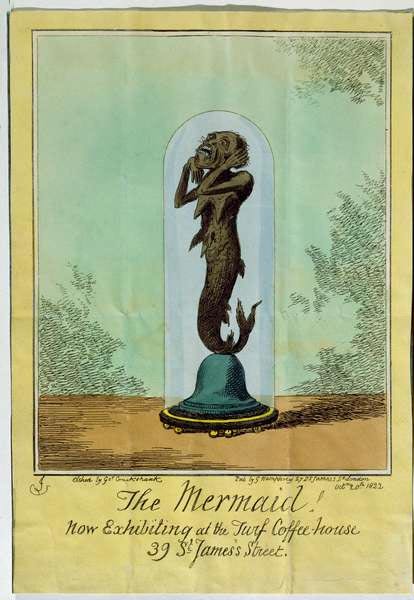
The Fiji Mermaid: What Was the Abominable Creature and Why Was It So Popular?
The Fiji (also spelled as ‘Feejee’) mermaid was a sideshow that gained popularity during the 19th century. The original Fiji Mermaid was displayed in 1842 by P.T. Barnum, an American showman and businessman, in the Barnum’s American Museum, New York. This curiosity attracted many visitors to the museum, and its popularity is attested in the fact that more Fiji mermaids would later be displayed in the United States.
Barnum’s mermaid is commonly said to have been destroyed in a fire that broke out and burned down Barnum’s museum in 1865. Nevertheless, at that time, the mermaid would have had been displayed at Kimball’s Boston Museum, and only perished when that museum too went up in flames in the early 1880s. It has also been claimed by some that the mermaid was rescued from (either one of) the fires, and is still being displayed today.
A Mermaid in the US?
The story of the Fiji mermaid in the United States begins with the arrival, in the middle of July 1842, of an Englishman by the name of ‘Dr. J. Griffin’ (who was actually Levi Lyman, an associate of Barnum’s), a supposed member of the ‘British Lyceum of Natural History’, in New York. Griffin, it seems, brought with him a mermaid, which was claimed to have been caught near the Fiji Islands in the South Pacific. News of Griffin’s arrival, along with his strange specimen was known by the press, and reporters went to Griffin’s hotel, demanding to see the mermaid. When he had given them a glimpse of what he had brought with him, they were convinced that it was real.
- Are tales of mythical mermaids inspired by a real-life medical condition?
- Ten Discoveries of 2014 that Suggest there is Truth to Ancient Myths and Legends
- Ring of Skulls: Ancient and Modern Sacrifices to the Water Gods

P.T. Barnum's Feejee mermaid from 1842. (Public Domain)
Not long after this, P. T. Barnum visited the offices of the major papers in New York, where he explained that he had been trying to convince Griffin to display the mermaid in his museum. Unfortunately, the Englishman was reluctant to do so. It also ‘so happened’ that he had prepared an advertisement (which contained the woodcut of a typical European mermaid) for the exhibition in advance, which was now of no use to him. Therefore he gave it to the papers, who decided to print the woodcut. Barnum is said to have also distributed 10,000 pamphlets, again with depictions of seductive mermaids, around the city.
This was all a publicity stunt, and soon, Griffin’s Fiji mermaid became the hottest topic in New York, and eventually, Griffin agreed to display his mermaid for a week at Concert Hall on Broadway. The week-long exhibition was a hit with the people, and, as a result, was allowed by Griffin to be displayed in New York for a longer period of time. It was agreed that it could be displayed in the Barnum’s American Museum for a month. Apart from the exhibition, Griffin also gave lectures to the crowds that came to see the mermaid.

Phineas Taylor (P.T.) Barnum. (Public Domain)
What the crowds saw was definitely not the beautiful, bare-breasted mermaids as depicted on Barnum’s promotional material. Instead, it was the preserved body of some small abomination that greeted them when they visited the exhibit. Indeed, it would later be revealed that the Fiji mermaid was actually the top half of a juvenile monkey sown onto the bottom half of a fish. It may be mentioned that Barnum did not create the Fiji mermaid, and that such objects had been made in Asia (Japan and the East Indies) long before the showman had acquired his so-called mermaid.
The Creation of the Mermaid
The famous Fiji mermaid is thought to have been made in Japan around 1810, where this was allegedly a traditional art form amongst fishermen. Barnum’s mermaid was bought by Dutch merchants, who then sold it to an American sea captain by the name of Samuel Barrett Eades in 1822. Eades paid a huge amount of money for the mermaid, but was not able to make a fortune from exhibiting it. Following his death, the mermaid was given to his son, who sold it to Moses Kimball. It was Kimball from whom Barnum had leased the mermaid.

A depiction of what would later come to be known as the Fiji mermaid, commissioned by Captain Samuel Barrett Eades. (Public Domain)
Losing the Fiji Mermaid
Following the month-long display in Barnum’s American Museum, the Fiji mermaid went on a Southern Tour, which had to be cut short due to a feud that it sparked in South Carolina. After that, the Fiji mermaid spent its time between Barnum’s museum and Kimball’s in Boston, for the next 20 years. In 1859, the Fiji mermaid went on a tour in London, and when it came back, was displayed in Kimball’s Boston Museum, its last known whereabouts.
- The Strange Merman of Banff: Legendary Lake Monster or Just a Trading Post Treasure?
- The Evolution of Sea Monsters on Medieval Maps
- Perseus: Powerful Demigod wth Mighty Weapons

The Banff Merman, similar to a Fiji mermaid, on display at the Indian Trading Post. (Public Domain)
According to one belief, the Fiji mermaid was destroyed when a fire broke out in Barnum’s museum in 1865. It has, however, been pointed out that at that point of time, the mermaid would have been in Kimball’s museum. Therefore, it has alternatively been suggested that the mermaid only disappeared in the early 1880s, when Kimball’s museum was destroyed by a fire.
Another alternative is that the Fiji mermaid somehow survived, and ended up in Harvard’s Peabody Museum of Archaeology and Ethnology. Whilst this museum possesses a Fiji mermaid, it is unknown if it is ‘the original’ Fiji mermaid. There are also other museums in the world that display Fiji mermaids, perhaps an attestation of people’s fascination with this subject, even though they are fakes.
Featured image: [Top] Fiji Mermaid, in the Folklore section at the Haus der Natur (House of Nature), a natural history collection in Salzburg, Austria. (CC BY-NC-SA 2.0) [Bottom] P.T. Barnums Feejee mermaid (Public Domain)
By Wu Mingren
References
American Social History Productions, Inc., 2016. The Fee Jee Mermaid Exhibit. [Online]
Available at: http://lostmuseum.cuny.edu/archive/exhibit/mermaid/
Boese, A., 2015. The Feejee Mermaid. [Online]
Available at: http://hoaxes.org/archive/permalink/the_feejee_mermaid
Early, A., 1998. The Little Mermaid?. [Online]
Available at: http://news.harvard.edu/gazette/1996/10.17/TheLittleMermai.html
Morisy, M., 2013. Objects of Intrigue: Fiji Mermaid. [Online]
Available at: http://www.atlasobscura.com/articles/objects-of-intrigue-fiji-mermaid
Pednaud, J. T., 2014. The Feejee Mermaid – The Famous Fake. [Online]
Available at: http://www.thehumanmarvels.com/the-feejee-mermaid-the-famous-fake/
Viscardi, P., 2016. Manmade Mermaids. [Online]
Available at: http://www.horniman.ac.uk/collections/stories/manmade-mermaids/story-chapter/mermaid-species
















Comments
The feud in South Carolina was between 2 newspapers who wrote reviews when P.T. Barnum’s uncle, Alanson Taylor, exhibited the mermaid. The Courier claimed the mermaid was real while The Mercury wrote a review by a naturalist, the Rev. John Bachman stating the mermaid was a crude hoax perpetrated by the Yankees. Evidently, the feud soon progressed to more than a war of words. Sources say that the argument would have resulted in a duel had friends not intervened. Regardless, the exhibition was cut short.
Maybe it’s just me, but this Asian practice of sowing animals in half and re-attaching them togather seems inhuman. Kind of like Frankenstein’s monster. Are there any other forms of this ‘art’ known? As in, where other animals with the heads/tails/extremities of other species found?
- Moonsong
--------------------------------------------
A dreamer is one who can only find his way by moonlight, and his punishment is that he sees the dawn before the rest of the world ~ Oscar Wilde